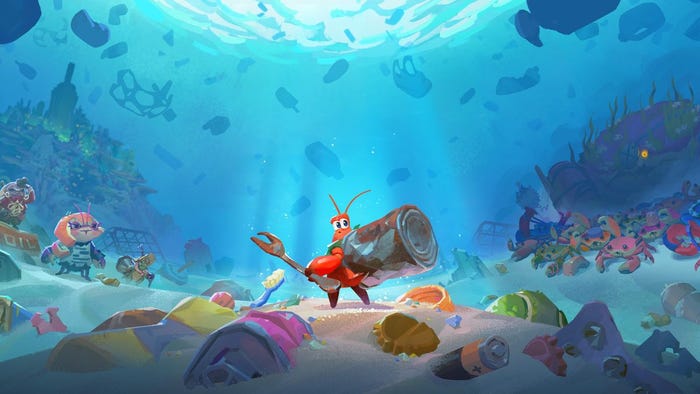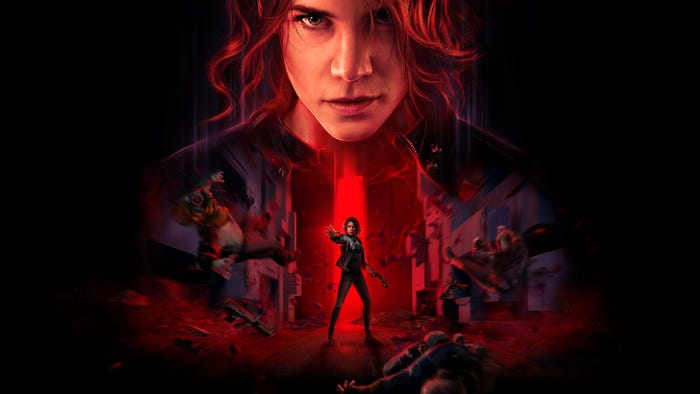This Year in Video Game Criticism: Farewell, 2013
This week, our partnership with game criticism site <a href="http://www.critical-distance.com/">Critical Distance</a> brings us Eric Swain's year-end roundup of the best of the best of 2013 games criticism.

This week, our partnership with game criticism site Critical Distance brings us Eric Swain's year-end roundup of the best of the best of 2013 games criticism. Here we are at the end of 2013, on the cusp of a new year, we at Critical Distance look back at all of the great criticism of the year. We trudged through the 1265 links we featured in the 2013 entries of TWIVGB and then checked the additional 50 recommendations you, the readers, submitted for consideration. From all of that we did our best to whittle a curatorial list of the most memorable, most important and most representative critical pieces of year. Critical Distance is proud to present the 2013 edition of This Year in Video Game Blogging.
Publications
Originally we called this print, but as the world moves towards digital, the specialist publications have begun to emerge. What used to be collaborative blogs has emerged into specialist publications with a wide variety of voices and names contributing. Alan Williamson's first full year of Five Out of Ten magazine put out a load of great work. Too many names to list here – 17 in all – contributed high quality critical work in its pages. Another digital magazine, that got its start this year, is Zoya Street's Memory Insufficient with 7 issues to its credit so far. Ghosts In The Machine is a short story anthology of 13 pieces by a variety of video game critics edited by Lana Polansky and Brendan Keogh.
Critical Video Game Blogging
Every year the focus of most of the work is on the games themselves, ranging from a holistic overview, to narrowing in on a single aspect or connecting it to the greater trends and themes of the medium. This is true for games of the present and of the past. Without a doubt the most talked about game of the year is Bioshock Infinite. Cameron Kunzelman was kind enough to collect a lot of the early writings of the game soon after its release. Leigh Alexander examines her own reaction to Bioshock Infinite and finds that the same formula is cracking at the seams as time has passed it by. Matthew Armstrong calls the game out on the difference between subtlety and cowardice, "trying to play dress-up as an intellectual exercise in what video games can accomplish." Meanwhile, Tevis Thompson takes not only the game to task, but the mainstream reviews and their lack of critical rigor towards it. While Bishock Infinite may have generated the most, Gone Home certainly generated the most variety. In an emotion reflection by Merritt Kopas, she revealed that she cried a number of times. "This is a videogame. About girls in love. That shouldn’t be exceptional in and of itself, but it is." Leigh Alexander explores the nostalgia and the reflections of the time, Riot Grrls included, within Gone Home. Almost as a counter Maddy Myers explains how the game doesn't reflect her experience of high school or the world. Scott Nichols on his blog Gamerly Musings explains why he spoiled a certain aspect of the narrative in his review of Gone Home and why he felt it wasn't something people should have held back. Clockworkworlds' Austin Walker reads between the lines of many of the artifacts of Terrence's past and finds he may be the victim of child molestation. Todd Harper looks into the Christian artifacts and what they represent about the different members of the family regarding their faith and the game as a whole. Naomi of Dead Pixel looks at the one point in the game where Kaitlin asserts her own will over the player's to keep her sister's privacy. Tom Chick at Quarter to Three asserts that The Last of Us has real heart, but not much else. Errant Signal's Chris Franklin calls The Last of Us "perhaps the best possible version of a fundamentally flawed design ideology; a perfect implementation of an imperfect idea." Stephen Beirne looks at The Ladder of Us and how Naughty Dogs seems terrified of its audience. At Medium Difficulty, Javy Gwaltney focuses in on Bill, one of the secondary characters, and how his depiction resonates out to the larger world of the work. Leigh Alexander writes for Gamasutra on the untimely tragedy of Grand Theft Auto V and for all the open world bluster, how confining the game ultimately feels. Cameron Kunzelman asks why GTA5 is so conservative, saying about the series, "[it] has always been about selling our own shitty culture back to us and then explaining that we're transgressive because we buy it." Anjin Anhut at How To Not Suck At Game Design deconstructs that satire of GTA5 or lack there of and how it can't subvert what is already too outrageous. Meanwhile, Tom Bissell writes a letter to Niko Bellic about Grand Theft Auto V at Grantland. Proteus co-creator Ed Key responds to contentions that his game was not a game by asking "What Are Games?" L. Rhodes chimes in that the discussion surrounding Proteus is less to do about the experience of playing it than it does justifying Proteus. Ian Bogost, meanwhile, wrote a trio of artisanal reviews about the game. Line Hollis compares Dear Esther and The Stanley Parable and what they have to say about fate and a deterministic universe. Chris Franklin aka Campster, commits to a holistic reading of The Stanley Parable since its meaning only becomes apparent when viewed as a possibility space and not a single true playthrough. Eric Swain on his column at PopMatters, took a look at the use of the camera in Brothers: A Tale of Two Sons and Kentucky Route Zero's indifference towards video games' platonic ideal. Also at PopMatters, is G. Christopher Williams piece about Rogue Legacy and its reflection about the contemporary economic status quo. And Scott Juster, of the Experience Points duo, labels Papers, Please as a game about the "banality of evil." Brian Boudreaux of Players Delight refutes the thinking of how Beyond: Two Souls is possibility space is limited and muses that the game's biggest step forward was also taken too early. At Unwinnable, Kris Ligman deconstructed Johnny's place as a part of the Saints Row franchise and how him ending up pushed to the side in Saints Row IV mirror's the series trajectory as a whole. Rhea Monique writes about Tomb Raider and how the scene of her being choked deeply affected her. Todd Harper explains why Actual Sunlight was just a little too much for him to bear and appreciated it didn't go for the easy ending. Gilles Roy at Play the Past looks at Call of Juarez: Gunslinger and what it has to say about storytelling and historical witnesses. At Kill Screen, Emanuel Maiberg explains how Call of Duty: Ghosts ends up turning the player into both a terrorist and a Nazi and how it's a pity it isn't self aware enough to realize it. Soha El-Sabaawi writes about the horror of the iOS indie game Year Walk for Ontological Geek. Brendan Vance dives into a deep close reading of Liz Ryerson's Problem Attic. The Extra Credits crew closely reads a single line in The Walking Dead and its wider significance in the work. Martin at Oh No! Video Games has a short piece on the thematic reading of episode 4 of The Walking Dead. Austin C Howe explores the postmodernism nature of Metal Gear Solid. James Clinton Howell looks at MGS4 and how it calls attention to how we become indifferent to human life by its own indifference to human life. Zolani Stewart looks at how Mortal Kombat 4 is different from its fighting game brethren. Mark Filipowich expands upon it and charts the trajectory of Mortal Kombat's violence and what it meat over the numerous entries. Chris Plante wrote a postmortem on The Bureau: XCom Declassified's 7 year development cycle for Polygon. At Medium Difficulty, Samantha Allen wrote A Dead Space Memoir and its mirroring of her own pain. Psepho at Commuter Gaming did a close reading of the virtual spaces in Porpentine's howling dogs. In his column at The Escapist, Robert Rath explains why Corvo from Dishonored is not an honorable gentleman. Max Chis calls Kane and Lynch 2: Dog Days the anti-shooter long before Spec Ops: The Line. Ceasar Bautista takes Susan Feagin's The Pleasures of Tragedy and applies it to Far Cry 2. Alex Duncan of The Animist blog look at what The Unfinished Swan as to say about creation and self-creation. Matt Sakey at Tap Repeatedly puts his Roman History degree to use and explores why Total War: Rome II fails to allow the player to be Roman. Liz Ryerson counters the indie game scene's trusisms regarding Michael Brough's Corrypt. And finally, like last year, we end this section on Sparky Clarkson's epic round up. He enlisted the help of 14 critics to help explain the greatness of as many 2013 releases in alphabetical order as possible.
Theory Blogging
A Lot of writing focused on specific games, but there was also a lot of writing thinking in the abstract. Not just the games, but regarding criticism itself. It's work about our views and our understanding. So of course we start off with Darius Kazemi's slideshow FUCK VIDEOGAMES. As well as Liz Ryerson's eye-destroying slideshow response RE: FUCK VIDEOGAMES. Anna Anthropy saved me a lot of headaches by writing the only Formalist v. Zinester piece one needs to read: "The FORMALIST VERSUS ZINESTER debate is as real as the NARRATOLOGY VERSUS LUDOLOGY debate, which is to say not at all." Tangentially related, is Dan Cox explanation of The Mechanics of Twine. Aevee Bee explained The Tyranny of Choice and its hold of game criticism and design. At Mammon Machine, Aevee Bee also wrote about need to explore beyond simple meaning, but also into the craft and form of our medium. Mattie Brice wrote her clarion call for game centric criticism and design with Death of the Player. Liz Ryerson wonders why she should love video games when the games seem embarrassed by their own nature and cannot love themselves. Chris Franklin explains what Ludonarrative Dissonance actually means in the face of so many incorrect assertions and usage. Zolani Stewart explains the problem with gun in video games is their lack of weight in the medium. Shane Liesegang of Bethesda wrote a piece explaining the concept of Impressionist Gameplay. Lars Doucet explains his newly coined term Procedural Death Labyrinths on his blog Fortress of Doors. Reetesh Yelamanchili explores how the world itself is understood as a game through the works of Game of Thrones and The Wire. Line Hollis thinks about how video games fail to meet the narrative arc without a serious change up with their rules within their run.
Culture Blogging
Gaming is much more than theory and works. It intersects with the real world. Any art form can only truly be understood by the culture that surrounds it. Art affects people and in turn people affect art. One must look at the people as well as the work. The material isn't as bad as previous years. however, I will not vouch for the comments and to be on the safe side, this section bears a Trigger Warning for discussions of sexism, harassment, rape and imagery of brutal violence towards women. Anita Sarkeesian uploaded the first four videos of her Kickstarted series Tropes vs. Woman in Video Games covering the Damsel in Distress in three parts and Ms. Male Character in one. Jenn Frank for Gameranx deconstructs what Dead Island Riptide's headless woman torso statue says about the culture that produced it and what it represents. Trigger Warning end. Polygon's Tracey Lien looks into the past to find the story the now calcified stereotype of video game being for boys. Samantha Allen wrote An Open Letter to Games Media about their comment policies and the image they are projecting at re/Action Magazine. In addition, she wrote about her work using video games to teach intersectionality at Emory University, first with Halo's Skulls and then with Bastion's Idols. Simon Parkin wrote an expose for Eurogamer about the Video Game Industrial complex and their complicity in advertising guns in the wake of the Newtown shooting and the NRA's deflection of responsibility. More studies are always being called for, so Jody Macgregor decided to see how those studies worked and what they actually had to say about behavior. Micheal "brainygamer" Abbot makes the humble case that in aggregate what we are consuming in our medium cannot be healthy for us and we must examine ourselves. Ian Williams describes the cycle of exploitation in the industry that is the de facto norm. "Keep Your Politics Out of My Video Games" Chris Franklin undermines, as he explains that such a contention is not really possible. Related, Aevee Bee uses Penny Arcade to explain the slow death satire appears to be experiencing thanks to puffed up self importance and abdication of responsibility. Simon Parkin says you should quit calling yourself a gamer lest you be tainted by what the community has become. At Unwinnable, Nate Andrews looks at the bizarre entity and community that sprung up around Salty Bet. Mark Filipowich laments upon the ephemeral nature of the internet and potential loss of all the great writing because of the dreaded 404.
Blogger of the Year
And now may I present Senior Editor, Kris Ligman: It has become customary in these end-of-the-year retrospectives to highlight the contributions of a particular writer, or writers, who helped define the year's critical discourse. In the past, the honor of "best blogger" has gone to a newcomer or standout writer who went from standing near the periphery of our reading of games writing to take center stage in an ongoing, ever-evolving critical discussion. Each year, these breakout talents have helped to raise the discourse to new heights. Previous year winners include L.B. Jeffries (2010), Kirk Hamilton and Kate Cox (2011), and Brendan Keogh (2012). This year, we are proud to name two remarkable women, Liz Ryerson and Samantha Allen as our joint Bloggers of the Year. Liz and Samantha have each left an indelible mark on how we thought about and discussed games in 2013. From her provocative game Problem Attic to her in-depth level analyses and essays, Liz (@ellaguro) reminds us of the raw, deeply-felt appreciation for structure and form that so ensnares us when we first come into contact with games. Coming at the medium from a different but equally captivating perspective, Samantha (@CousinDangereux)'s explorations of game systems as teaching tools and commentary on social systems and personal growth, and her heartfelt appeals not just to game-makers but journalists and community leaders to up their game and provide safer spaces for everyone, reveal the sort of profound emotional intelligence and personal candor she brings to all of her writing. We salute you both, Liz and Samantha, for your many contributions over the past year. And we look forward to your future work!
And Never Thought Upon
If I had to sum up the year overall, I'd say it seemed a bit bland, as if a malaise descended over everything. Something left and everyone puttered about, waiting for something to come. It of course had its high spots as you can see above and on my cutting room floor. Quality work will always exist. But 2013 seemed more like a gearing up as the universe gets its ducks in a row and everyone rushes about the stage to get into their places. We all felt like we were setting up and now hopefully we can get some payoff come the new year. A big thank you to all those who emailed in their suggestions and to all my colleagues new and old at Critical Distance. Next weekend we are back to the usual routine. So please don't forget to send in your suggestions for TWIVGB to our email and our twitter. From all of us here to all of you out there, have a Happy New Year.
About the Author(s)
You May Also Like









